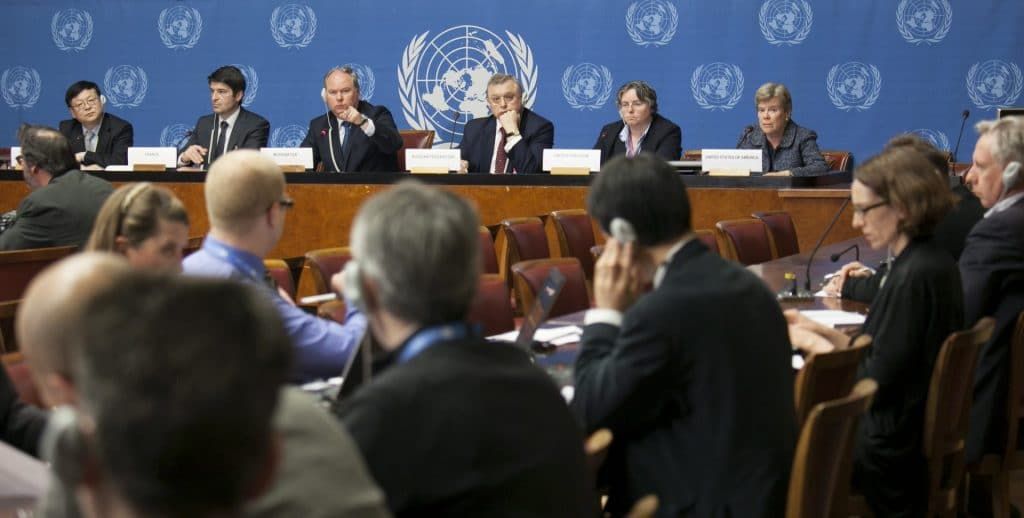Five nuclear weapon states vow to prevent nuclear war while modernizing arsenals
By Rebecca Davis Gibbons | January 17, 2022
 P5 Press Conference at the United Nations, April 19, 2013. The five Nuclear Non-Proliferation Treaty (NPT) nuclear-weapon states issued a joint statement in January 2022. Credit: Eric Bridiers. Accessed via Flickr. Attribution-NoDerivs 2.0 Generic.
P5 Press Conference at the United Nations, April 19, 2013. The five Nuclear Non-Proliferation Treaty (NPT) nuclear-weapon states issued a joint statement in January 2022. Credit: Eric Bridiers. Accessed via Flickr. Attribution-NoDerivs 2.0 Generic.
Early this month, the five nuclear weapon-possessing countries within the Nuclear Non-Proliferation Treaty (NPT) released a joint statement on preventing nuclear war and avoiding arms races. The statement, which was meant to coincide with the pandemic-delayed NPT Review Conference this month (postponed again until August 2022), sought to communicate that they take their responsibilities as nuclear-possessor states seriously. Instead, the statement highlighted a chasm between those seeking nuclear disarmament now and these five nuclear weapon countries.
The five countries—the United States, Russia, the United Kingdom, China, and France, the five permanent members of the UN Security Council often known as the P5—proclaimed that they “consider the avoidance of war between Nuclear Weapon States and the reduction of strategic risks as our foremost responsibilities.” They reiterated the 1985 Reagan-Gorbachev statement that “a nuclear war cannot be won and must never be fought” and argued that these weapons should only be used defensively to deter war. They also made the understated-but-obvious statement that “nuclear use would have far-reaching consequences.” Finally, they all but asserted that no other countries should possess nuclear weapons, presumably because more nuclear-armed states means more potential for nuclear use.
Yet these five nuclear weapon states are all modernizing or expanding their arsenals and establishing plans for nuclear use in a variety of circumstances. Their defense communities would likely say that nuclear deterrence must be credible to work, and for deterrence to be credible, adversaries must expect these weapons to be used in war.
Therein lies the paradox of nuclear deterrence: to never use them, use must be believable.
Set against the real backdrop of nuclear expansion and modernization, the joint statement highlights a stark reality: nuclear weapon states are not on the same page as those who seek vast reductions in the global stockpile of nuclear weapons. The latter argue that the former’s maintenance of most of the world’s 13,000 nuclear weapons presents a grave risk of use that threatens global security. They argue, in other words, that security does not stem from nuclear deterrence, but from nuclear disarmament.
The January 3 joint statement failed to mention the Treaty on the Prohibition of Nuclear Weapons, which bans nuclear possession and nuclear weapon-related activities. This treaty entered into force in January 2021 and has 86 signatories and 59 states parties. In previous joint statements, the five nuclear weapon states have rejected the new treaty, claiming that it undermines the NPT, sows division in the international community, and will not result “in the elimination of a single weapon.”
Still, the prohibition treaty is not entirely absent from the most recent joint statement, which acknowledged that “nuclear use would have far-reaching consequences.” This phrase alludes to the 2010 NPT Review Conference document that “expresse[d] its deep concern at the catastrophic humanitarian consequences of any use of nuclear weapons” and to the humanitarian initiative since then. Through several international conferences, the initiative has called attention to the devastating effects of nuclear weapons—to bodies, communities, and the Earth—and spurred the creation of the Treaty on the Prohibition of Nuclear Weapons.
But why not mention the prohibition treaty this time? It’s possible that the five nuclear weapon states may not agree on how to discuss the ban treaty. Or more likely, they want to avoid drawing attention away from the NPT, especially given their concerns about the relationship between the two treaties.
The omission could also reflect a softening of the five nuclear weapon states’ public rhetoric surrounding the Treaty on the Prohibition of Nuclear Weapons. For example, Bonnie Jenkins, US undersecretary of state for arms control and disarmament, said in September that the United States “still has concerns about the treaty, but we are also not telling countries that they shouldn’t sign and we’re not nearly as assertive as we were in the past about it.” (Rhetoric aside, the US government has pressured allies not to attend the March meeting of the Treaty on the Prohibition of Nuclear Weapons.)
In the joint statement, the five nuclear weapon states also reiterate their commitment to the NPT’s Article VI, which obligates them “to pursue negotiations in good faith on effective measures relating to cessation of the nuclear arms race at an early date and to nuclear disarmament, and on a treaty on general and complete disarmament under strict and effective international control.”
They are less clear, however, about what they are doing to achieve these goals.
The nuclear weapons-possessing NPT member states might cite their efforts with the US-Russian security dialogue, the Stockholm Initiative, the International Partnership for Nuclear Disarmament Verification, the Creating an Environment for Nuclear Disarmament initiative, and risk reduction efforts. Yet most non-nuclear weapon states are disappointed by the fruits of these disarmament efforts.
The large chasm between the five nuclear weapon states and those seeking nuclear disarmament now is not bridged by the former’s expressed “desire to work with all states to create a security environment more conducive to progress on disarmament.” For those seeking an outright ban, the reduction of nuclear weapons is a means of improving the security environment for all people—not a step to take once some kind of nebulous peace is achieved. In an increasingly strained security environment, the joint statement from the five nuclear weapon states communicates that now is not the time for nuclear reductions.
A joint statement—even one that lacks specifics and offers only vague platitudes—is better than no joint statement. This is especially true in this time of high tension among the five nuclear states. Still, the joint statement shines a light on unfilled expectations for the five nuclear weapon states to disarm. In broadcasting the large gulf between their rhetoric and actions, the five nuclear weapon states have undermined their credibility and, indeed, the Nuclear Non-Proliferation Treaty.
Together, we make the world safer.
The Bulletin elevates expert voices above the noise. But as an independent nonprofit organization, our operations depend on the support of readers like you. Help us continue to deliver quality journalism that holds leaders accountable. Your support of our work at any level is important. In return, we promise our coverage will be understandable, influential, vigilant, solution-oriented, and fair-minded. Together we can make a difference.
Keywords: NPT, Non-Proliferation Treaty, P5, nuclear risk, nuclear weapons
Topics: Nuclear Risk














